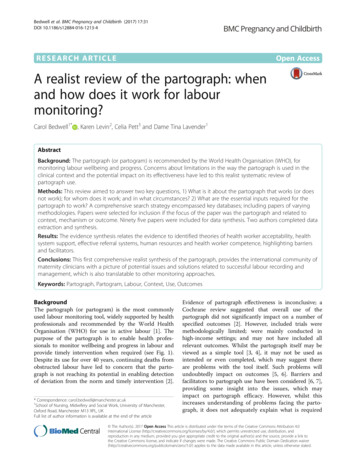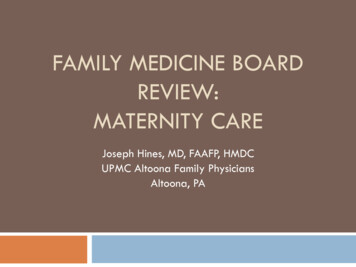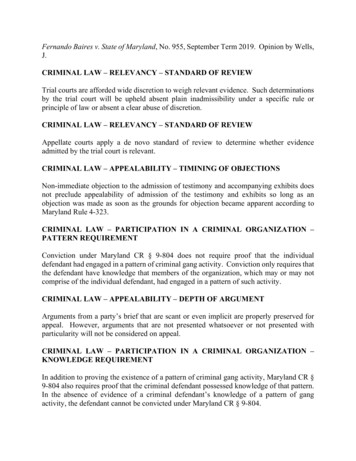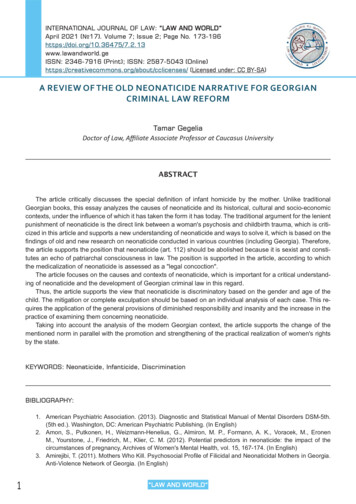
Transcription
Bedwell et al. BMC Pregnancy and Childbirth (2017) 17:31DOI 10.1186/s12884-016-1213-4RESEARCH ARTICLEOpen AccessA realist review of the partograph: whenand how does it work for labourmonitoring?Carol Bedwell1* , Karen Levin2, Celia Pett3 and Dame Tina Lavender1AbstractBackground: The partograph (or partogram) is recommended by the World Health Organisation (WHO), formonitoring labour wellbeing and progress. Concerns about limitations in the way the partograph is used in theclinical context and the potential impact on its effectiveness have led to this realist systematic review ofpartograph use.Methods: This review aimed to answer two key questions, 1) What is it about the partograph that works (or doesnot work); for whom does it work; and in what circumstances? 2) What are the essential inputs required for thepartograph to work? A comprehensive search strategy encompassed key databases; including papers of varyingmethodologies. Papers were selected for inclusion if the focus of the paper was the partograph and related tocontext, mechanism or outcome. Ninety five papers were included for data synthesis. Two authors completed dataextraction and synthesis.Results: The evidence synthesis relates the evidence to identified theories of health worker acceptability, healthsystem support, effective referral systems, human resources and health worker competence, highlighting barriersand facilitators.Conclusions: This first comprehensive realist synthesis of the partograph, provides the international community ofmaternity clinicians with a picture of potential issues and solutions related to successful labour recording andmanagement, which is also translatable to other monitoring approaches.Keywords: Partograph, Partogram, Labour, Context, Use, OutcomesBackgroundThe partograph (or partogram) is the most commonlyused labour monitoring tool, widely supported by healthprofessionals and recommended by the World HealthOrganisation (WHO) for use in active labour [1]. Thepurpose of the partograph is to enable health professionals to monitor wellbeing and progress in labour andprovide timely intervention when required (see Fig. 1).Despite its use for over 40 years, continuing deaths fromobstructed labour have led to concern that the partograph is not reaching its potential in enabling detectionof deviation from the norm and timely intervention [2].* Correspondence: carol.bedwell@manchester.ac.uk1School of Nursing, Midwifery and Social Work, University of Manchester,Oxford Road, Manchester M13 9PL, UKFull list of author information is available at the end of the articleEvidence of partograph effectiveness is inconclusive; aCochrane review suggested that overall use of thepartograph did not significantly impact on a number ofspecified outcomes [2]. However, included trials weremethodologically limited; were mainly conducted inhigh-income settings; and may not have included allrelevant outcomes. Whilst the partograph itself may beviewed as a simple tool [3, 4], it may not be used asintended or even completed, which may suggest thereare problems with the tool itself. Such problems willundoubtedly impact on outcomes [5, 6]. Barriers andfacilitators to partograph use have been considered [6, 7],providing some insight into the issues, which mayimpact on partograph efficacy. However, whilst thisincreases understanding of problems facing the partograph, it does not adequately explain what is required The Author(s). 2017 Open Access This article is distributed under the terms of the Creative Commons Attribution 4.0International License (http://creativecommons.org/licenses/by/4.0/), which permits unrestricted use, distribution, andreproduction in any medium, provided you give appropriate credit to the original author(s) and the source, provide a link tothe Creative Commons license, and indicate if changes were made. The Creative Commons Public Domain Dedication o/1.0/) applies to the data made available in this article, unless otherwise stated.
Bedwell et al. BMC Pregnancy and Childbirth (2017) 17:31Page 2 of 11Fig. 1 Types of Partograph. a. Composite partograph [18, 64]. b. Modified partograph [65]for the tool to be clinically effective. Greater depth ofunderstanding of the context and mechanism of partograph use is required in order to determine if andhow it can reach its potential.Literature suggests that there is widespread supportfor the partograph, a belief that it works and a professional will for it to succeed [4, 6, 8–10]. However, inorder to understand the issues facing the partograph andits impact on outcomes, a comprehensive evaluation ofthe evidence is required. The partograph is used as partof an approach to labour monitoring. As such, the partograph by its nature is a complex intervention, relyingon a number of factors for effective use, includinginteraction between a number of causal relations, behaviors and outcomes [11]. These complexities requiremore than a traditional review and this paper will reportthe findings of a review of factors which may impact onpartograph efficacy using realist review methodology [12].MethodsA realistic review approach is appropriate for researchsynthesis of complex interventions such as health servicedelivery [12–14]. Complex interventions are embeddedin health or social systems and are therefore influencedby differences in context [12]. The partograph is typicalof a complex health intervention in that its use is affected by a number of factors related to design, context,implementation and management, and because it requires the active input of individuals to be effective [12].Traditional systematic reviews are evaluative, focusingon outcome and whether or not an intervention works.The advantage of the realist review approach is that it is
Bedwell et al. BMC Pregnancy and Childbirth (2017) 17:31Page 3 of 11explanatory, allowing the researcher to explore why andhow such interventions may work (or not) and in whatcontext [12, 13].The review process itself consists of five steps; clarifyingthe scope of the review, searching for evidence, appraisingprimary studies and extracting data, synthesising anddrawing conclusions, dissemination, implementation andevaluation (outlined in Fig. 2) which will be explained inthe context of the partograph review.intervention and the context of its use which may impact on its effectiveness. These were situated under anoverarching theory of an enabling environment; that is,for the intervention to work at all the environment andcontext in which the intervention occurs must be supportive [15]. Five related theories were identified,consisting of: health worker acceptability, health systemsupport, effective referral systems, human resources andhealth provider competence (see Fig. 3).Clarifying the scope of the reviewSearch for evidenceThis requires identification of the review question, refining of the question and articulation of key theories to beexplored. The realist review approach is described as ‘theory driven’ relying on the researcher to make explicit anypresumptions of how and why the intervention works,prior to conducting the review. This also defines the overall scope of the review and provides a framework for analysis. A vital aspect in this process is input from keystakeholders, such as policy makers and experts in thefield. This allows for ‘expert framing’ of the issues [12].Key literature is also considered in determining the reviewtheories. For this review an expert meeting ‘Revitalizingthe Partograph: Does evidence support a global call to action?’ highlighted the potential factors which may impacton correct and consistent use of the partograph [6].Furthermore, an expert stakeholder group, consisting ofglobal experts in the partograph, was convened. Thesestakeholders provided input into identification and refining of the review question and protocol development,along with review of the final report.The review was guided by two questionsA comprehensive search strategy was employed to identify relevant papers for inclusion. Databases searchedcomprised of Medline, EMBASE, CINAHL, ProQuest,and the Cochrane database of systematic reviews. Majorhealth advisory organisations, such as WHO were alsosearched for relevant policy and guidance documents.Search terms included various combinations of “partograph” OR “partogram” OR “cervicograph” OR “cervicogram” AND “labor/labour” AND “progress” AND/OR“monitor or monitoring” OR “delay” OR “tool/tools” OR“management” OR “record/recording” OR “reading” OR“chart/charting” OR “measurement” OR “length” andderivatives thereof.Purposive sampling was used to identify papers whosemain focus was relevant to both the research questionand the theories to be tested. Papers were includedwhose main focus was labour and the partograph (including partogram, cervicograph or cervicogram) andwere related to the guiding theories through context,mechanism or outcome. No restrictions were applied tolanguage, dates of publication or to the types of studiesconsidered for inclusion. Included literature comprised1. What is it about the partograph that works (or doesnot work); for whom does it work (e.g., midwives,obstetricians, women); and in what circumstances(e.g., urban/rural setting, country)?2. What are the essential inputs required for thepartograph to work?The review theories were developed in relation to thevarious aspects of the partograph as a complexFig. 2 Realist review processFig. 3 Identified theories
Bedwell et al. BMC Pregnancy and Childbirth (2017) 17:31of papers of various methodologies, policy and guidancedocuments, audits, grey literature and opinion pieces. Theinitial search was completed in October 2013 and repeated in October 2015. Following removal of duplicates416 papers were screened on title and abstract by two authors. A further 291 full papers were screened, resulting in95 papers for inclusion (see Prisma diagram, Fig. 4).Appraisal of evidencePawson [12] argues that ‘fitness for purpose’ is the mostimportant factor in determining relevance for inclusionof evidence and rejects exclusion of papers on the basisof quality alone; the synthesis itself determines the valueof the evidence. For this reason, all studies with useabledata were included, regardless of quality. However, anunderstanding of quality is relevant for the ultimate synthesis [16]. Therefore, a quality assessment was madeusing the MMAT tool (version 11) [17], thus allowingfor a simple review of quality for studies of varyingmethodologies.Data extraction and synthesis of the evidenceA simple data extraction tool was devised and was completed for each paper identifying aspects which relatedto the context, mechanism or outcome of the partograph. This provided a simple overview of the data,allowing links to be developed and related to the predefined theories. Pawson et al. [12] suggest that data extraction is not linear and evidence will continue toemerge during the process. This did occur with referralto the included papers continuing throughout the synthesis process as further links were developed and concepts identified. Once extracted, data were interrogatedFig. 4 PRISMA flowchartPage 4 of 11using specific questions related to each theory. Thishelped to clarify and synthesise the data within each individual theory.ResultsNinety five papers were identified for inclusion (seeFig. 4). These included primary research, reviews, guidance documents and opinion papers, in line with therealist review philosophy. For the purposes of theevidence synthesis, only primary research and review papers were included. The majority of included papers related to low-resource settings, with very few in mediumor high resource settings.The key evidence synthesis is presented below in relation to each relevant theory (Tables 1, 2, 3, 4 and 5) andwill be discussed in relation to the research questions.DiscussionThis review aimed to answer two key guiding questions,which will be discussed below.What is it about the partograph that works (or does notwork); for whom does it work (e.g., midwives,obstetricians, women); and in what circumstances (e.g.,urban/rural setting, country)?What is it about the partograph that works?A Cochrane review of the partograph suggests that evidence to support improvement of clinical outcomes islimited2. However, evidence from other studies indicatesthat partograph use may contribute to shorter laboursand some improvement in maternal and fetal outcomes[18–21]. Health care workers found the modified partograph the most user-friendly version [3, 22, 23], with the
Bedwell et al. BMC Pregnancy and Childbirth (2017) 17:31Page 5 of 11Table 1 Health worker acceptabilityQuestionNo of studiesEvidence synthesisQualityDo health workers use thepartograph?n 18Wide variation in the reported routine use of the partograph inpractice, from 8 to 80%.The partograph is more likely to be used in tertiary settings, byphysicians and midwives.The partograph is more likely to be used in public facilities.Specific training in the partograph may increase use.There is some evidence, although limited, to suggest thatexperience does not have any impact on use.There is some evidence, although limited to suggest thatconfidence in using the partograph increases its use in practice.**Low [25, 33, 36, 41, 48]*V low [24, 26, 28–32, 42,43, 47, 66]What are health workers’attitudes towards thepartograph?n 9Evidence suggests that health workers display positive attitudesto the partograph.A positive attitude alone does not appear to increase partographuse in practice.**Low [23, 36, 40, 41]*V low [29, 32, 42, 47, 49]What is the impact ofpartograph use on clinicaloutcomes?n 6Evidence from RCTs suggests there is no improvement in clinicaloutcomes when a partograph is used.Pre- and post-implementation studies suggest that use of thepartograph may contribute to shorter labours, reduced sepsis,reduced postpartum haemorrhage, and improved fetal outcomes.There is evidence, although limited, to suggest that the partographmay improve outcomes in low-resource settings.***Medium [18, 22, 56]*V low [19–21]What is the impact of thepartograph on quality of care?n 0None of the included studies assessed quality of care in relation topartograph use.Data related to improved maternal outcomes post-intervention, such asfewer vaginal examinations, may indicate that women may have a betterexperience of labour, but there is no empirical evidence to support this.What is the impact ofpartograph use on maternalsatisfaction?n 0No studies evaluated maternal satisfaction.Is the partograph a useabletool?n 3The modified partograph is easier for providers to use than thecomposite partograph and may improve outcomes.latent phase of the composite partograph considered difficult to complete. The modified partograph also appearsto improve outcomes including reduced caesarean section rate, augmentation of labour and admission to neonatal unit when compared to the composite partographin low-resource settings [23].***Medium [22, 23]**Low [3]Overall completion of the partograph (to pre-definedstandards) is poor, which is likely to impact on the utilityof the tool in clinical practice. The sections of the partograph which are most likely to be completed are thoserelating to progress (cervical dilatation) and fetal wellbeing (fetal heart rate) [24–27]. Those that were poorlyTable 2 Health system supportQuestionNo of studiesEvidence synthesisQualityWhat is the organisationalcommitment to partograph use?n 2There is very little available evidence of organisationalcommitment.There is limited evidence of organisational commitment inhigh-resource settings.**Low [23]*Very Low [29].What is the policy and guidancerelated to partograph use?n 4 studiesThe main guidance documents are those produced by WHO.n 5 guideline There is a lack of available guidance at the facility level.documentsLimited evidence suggests that available facility level guidancepromotes partograph use in practice.Guidance [64, 65, 67–70]*V low [24, 25, 30, 49]Is the partograph available?n 8There is a lack of availability of the partograph in somesettings, particularly health centres.**Low [25, 33, 38, 43, 48]*V low [29, 30, 47]Is there support for partographuse in terms of resourceprovision?n 2Equipment required for partograph completion may not beavailable; for example sphygmomanometers, thermometersand fetoscopes.*V low [29, 31]How can the partograph beimplemented effectively?n 2, plus1 auditThere is little evidence to determine the most effective method***Medium [18]of partograph implementation.*V low [20, 50]Pre-implementation training and post-implementation audit andfeedback may have a positive impact on accuracy and frequency ofpartograph completion.
Bedwell et al. BMC Pregnancy and Childbirth (2017) 17:31Page 6 of 11Table 3 Effective referral systemsQuestionNo ofstudiesWhich methods of working ensure n 2effective referral?What are the issues or barriersrelated to effective referral?n 10Evidence synthesisQualityThere is confusion between healthcare worker roles, particularly betweenmidwives and physicians, which may impact on the effectiveness of referral.The partograph is not always used as a communication tool between healthworkers at handover of care or referral.Partograph findings are not always acted upon.*V low [29, 32]The partograph is a trigger for referral. However, there is some inconsistency**Low [23, 36, 38]in referrals based on partograph findings.*V low [20, 28, 29,It is unclear if referrals made as a result of partograph use are appropriate.31, 32, 37, 39]There was little evidence of additional barriers to transfer, e.g., transport, cost etc.completed related to maternal wellbeing [24–28]. However, this may reflect ease of use in completing particularsections, availability of equipment or participants understanding of the partograph, rather than the tool itself [3,29–31]. Whilst some view the partograph as difficult ortime consuming to complete [30, 32, 33], there is evidence that other, non-professional, cadres of staff cancomplete the partograph effectively [34, 35].The partograph does appear to work as a trigger forreferral and transfer [20, 28, 31, 32, 36–38], one of itsprimary purposes. However, evidence related to othertypes of decision-making, for example augmentation oflabour, based on partograph findings is limited and thereis some suggestion that partograph findings may not always be acted upon [29]. The success of the partographas a communication tool at handover of care is limited[23, 29] and women who are transferred to tertiary unitsare not always sent with the partograph commenced atthe referring facility [39].For whom does it work?In terms of improved outcomes for women andnewborns, there is conflicting evidence as to whetherthe partograph works, although studies in low-resourcesettings suggest that it may have positive impact [18–21]. There is no evidence that partograph use is detrimental to outcomes [2]. Whilst there is no data relatedto maternal satisfaction or quality of care when thepartograph is used, suggestions of fewer vaginal examinations, reduced length of labour and referral may indicate that women are receiving more appropriatetreatment and intervention [18–21, 37].Midwives appear to be satisfied with the partograph asa usable tool for monitoring labour [18, 40]. Positive attitudes towards the partograph are displayed by bothmidwives and doctors, but less so by other cadres ofhealth care worker who also use the partograph [32, 36,40–42]. It is clear that positive attitudes alone do nottranslate into partograph use in practice. This may befor a number of reasons such as availability, time, workload and organisational culture [23, 29–32, 43].One advantage of partograph use is that it enableshealth workers to take individual responsibility forlabour management within their own sphere of practice [44]. However, confusion over roles and responsi
management, which is also translatable to other monitoring approaches. Keywords: Partograph, Partogram, Labour, Context, Use, Outcomes Background The partograph (or partogram) is the most commonly used labour monitoring tool, widely supported by health professionals and recommended by the Wor











